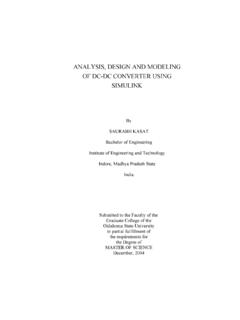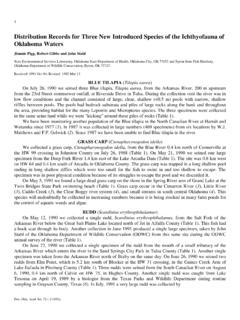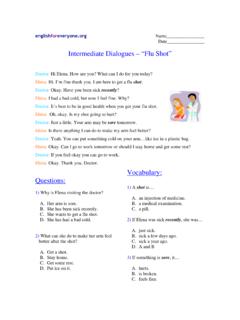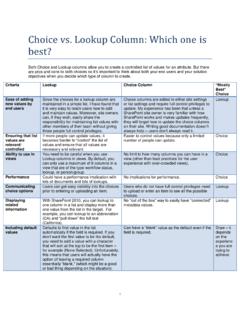Transcription of A STUDY OF CAREER CHOICE FACTORS - Digital …
1 A STUDY OF CAREER CHOICE FACTORS AND STUDENTS ACADEMIC SUCCESS AT AN AVIATION SCHOOL By JAMES FRANKLIN PENDERGRASS Bachelor of Science in Business Administration University of Tulsa Tulsa, Oklahoma 1983 Master of Science in Occupational and Adult Education Oklahoma State University Stillwater, Oklahoma 1997 Submitted to the Faculty of the Graduate College of the Oklahoma State University in partial fulfillment of the requirements for the Degree of DOCTOR OF PHILOSOPHY May, 2008 ii A STUDY OF CAREER CHOICE FACTORS AND STUDENTS ACADEMIC SUCCESS AT AN AVIATION SCHOOL Dissertation Approved: Lynna J. Ausburn Dissertation Adviser Mary Jo Self Robert E. Nolan Steven Marks A. Gordon Emslie Dean of the Graduate College iii TABLE OF CONTENTS Chapter Page I. INTRODUCTION.
2 1 Background ..1 Statement of the 6 Purpose of the Research Rationale for a Mixed-Method STUDY ..8 Theoretical Framework ..9 Researcher Perspective ..12 Limitations of the Definitions Related to the STUDY ..13 Summary and Overview of the Significance of the STUDY ..17 II. REVIEW OF THE 18 The Problem of College Student Dropouts ..19 Defining College Dropout ..23 Retention Rates for College Students Are Not Improving ..26 High Attrition Rates in Technical High Attrition in Aviation Training ..31 FACTORS Affecting CAREER Choices, Culture, Motivation, and Retention ..35 Summary ..41 III. Introduction and Overview of the Research Approach and Design ..44 Population and Sample ..47 Instrumentation ..49 Quantitative Phase ..53 Qualitative Phase ..55 Data Analysis ..58 Quantitative Phase ..59 Qualitative Phase ..60 Summary ..61 iv Chapter Page IV.
3 PRESENTATION OF Demographic Data ..63 Experience Prior to Aviation FACTORS Affecting Students Decisions to Choose a CAREER in Aviation ..69 Qualitative Data ..70 Open-Ended Questionnaire Telephone Program-Completers ..72 Non-Completers ..74 V. SUMMARY, CONCLUSIONS, AND Summary of Conclusions and Discussion ..80 REFERENCES ..90 APPENDICES ..99 APPENDIX A - SURVEY APPENDIX B - SURVEY LETTER ..105 APPENDIX C - PARTICIPANT CONSENT FORM ..108 APPENDIX D - TELEPHONE INTERVIEW FORM, COMPLETERS ..111 APPENDIX E - TELEPHONE INTERVIEW FORM, NON-COMPLETERS ..114 APPENDIX F - INSTITUTIONAL REVIEW BOARD APPROVAL v LIST OF TABLES Table Page 1. Median Annual Earnings of Full-time, Full-year Workers Selected Years, 2. Comparison of Demographic Data of STUDY Sample with Current School 3. Prior Training of Respondents by Completers and 4. When Students First Became Interested in a CAREER in 5.
4 How Students First Learned About Aviation 6. Aviation Activities Students Were Involved in Before 7. Persons in Aviation Students Knew Before 8. FACTORS That Had the Greatest Influence on Students Choosing Aviation 9. Persons Who Had the Greatest Influence on Students Choosing Aviation vi LIST OF FIGURES Figure Page 1. Theoretical and Conceptual Framework for the 2. Institutional Retention and Overall Persistence Rate of 1980-90 Beginning Postsecondary Students after 5 1 CHAPTER I INTRODUCTION Background Academic success in college may be defined in different ways. In The College Success Book: A Whole-Student Approach to Academic Excellence, Groccia (1992) wrote, Attaining academic success requires that you become flexible in your STUDY habits and learn to modify them to fit new learning environments (p. 3). Browne and Keeley (1997) have suggested that the right attitude and good strategies combine to equal excellence in college.
5 Then, the question arises; can academic success be defined in terms other than excellence? Kuh, Kinzie, Schuh, Whitt, and associates (2005) advised there is no single blueprint for student success. The institutional mission statement should emphasize and define what student success means in the local context (p. 299). Kuh et al. believed students who cannot discern meaning from their college activities often report academic difficulty or social isolation, and are at risk of leaving school (p. 109). Former New York Yankee baseball Hall of Fame catcher Yogi Berra has been quoted as saying, You got to be careful if you don t know where you re going, because you might get there (1998, p. 102). Groccia (1992) linked academic success to goal achievement and advised students: Having CAREER goals helps provide direction and focuses your attention on attainable outcomes of the educational process. Knowing where you are going with your academic program, in terms of clear goals, helps stimulate and maintain motivation.
6 Motivation has been shown to be a critical component of academic success. Therefore, clarifying your CAREER goals can result in immediate as well as long-term gain. (p. 46) 2 Berra added, If you don t set goals, you can t regret not reaching them (p. 103). Webster defined to succeed as to accomplish something desired or intended (Webster s II New Riverside University Dictionary, 1984). Schools have established policies to help insure that students are successful in achieving their goals. In such a policy, The University of Maryland (2004, para. 1) stated, The goal of the Student Academic Success-Degree Completion Policy is to promote undergraduate student success. The policy requires students to complete required courses, have appropriate grades, and meet certain progress benchmarks. This will allow all students to demonstrate continuing progress in their majors (para. 2). The Department of Education has defined satisfactory academic progress in the Code of Federal Regulations (CFR).
7 Institutions who desire to participate in the Title IV, Higher Education Assistance program are required to have a standard that insures undergraduate students complete their program of STUDY in no more than 150 percent of the published length of the educational program. At the same time, students must demonstrate acceptable grades or completion of work projects (Code of Federal Regulations, ). Lincoln University of Missouri, which has such a program, states The mission of Academic Success and Student Retention is to provide academic support using a comprehensive array of activities and services to assist students throughout their journey to a successful graduation (2006, Mission Statement). Students who wish to succeed in college must take an active role in their learning, according to Browne and Keeley (1997). To be an active learner, the student must stay in school. This links academic success directly to persistence. However, more college students leave college without completing a degree than those who graduate (Tinto, 3 1993).
8 Tinto pointed out that there are serious consequences for both students who drop out of college, and for their schools. Dr. Boyce Watkins, who earned a from The Ohio State University, also tied academic success to persistence. In explaining why he believes he was a successful student in college he said, I sometimes failed tests, I received bad grades from time to time, and there were periods when I endured intense humiliation. But I (2004, pp. 1-2). Dr. Watkins added, ..you have to go into the situation ready to work as hard as you can to solve your problems and reach your goals. Never ever give up, because giving up is the only way to guarantee that you have NO CHANCE to be successful (p. 46). One benefit of persistence and completing a college degree is access to higher paying, and more prestigious careers. The National Center for Educational Statistics (2006) reported that in 2004 males between the ages of 25 and 34 who completed the bachelor s degree or higher had annual earnings 67% higher than a male high school graduate.
9 This is an increase from a 19% advantage in 1980. Females with a bachelor s degree or higher, earned 68% more than females with a high school diploma, or the equivalent. Prior to 1990, most research into the problem of student retention focused on four-year institutions. However, Pascarella and Terenzini (2005) found that 40 percent of students enrolled in college in the are now attending community colleges. Thus, community colleges are greatly impacting CAREER training, and this includes training for a CAREER in aviation. 4 Less than 20 percent of the schools certificated by the Federal Aviation Administration to train pilots and maintenance technicians are identified as universities or colleges. Another eight percent of aviation programs are taught in community colleges; the majority of these programs are for training aircraft maintenance technicians (U. S. Department of Transportation, Federal Aviation Administration [FAA], 2006).
10 This suggests that more than two-thirds of the students entering aviation training are not degree seeking students. Still, they are completing some college and the National Center for Educational Statistics report showed that students completing some college have greater earnings than high school graduates (see Table 1). Table 1 Median Annual Earnings of Full-time, Full-year Workers Ages 25-34 Selected Years, 1980 2004 1980 1985 1990 1995 2000 2004 Male Totals $40,600 $39,100 $36,700 $34,200 $37,800 $36,300 High school graduate 38,800 35,200 32,000 29,700 32,300 30,400 Some college 40,800 39,800 37,600 33,000 38,000 36,400 Bachelor s degree or higher 46,300 48,200 46,000 46,400 50,900 50,700 Female Totals 27,600 29,100 28,900 27,500 30,100 31,000 High school graduate 25,500 25,000 23,700 21,800 23,500 24,000 Some college 27,800 28,900 29,000 26,700 27,800 28,800 Bachelor s degree or higher 34,100 36,900 38,800 37,300 39,900 40,300 Note: Earnings in constant 2004 dollars.









